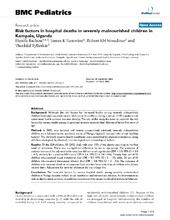| dc.description.abstract | Background: Although the risk factors for increased fatality among severely malnourished children have been reported, recent information from Africa, during a period of HIV pandemic and constrained health services, remains sketchy. The aim of this study has been to establish the risk factors for excess deaths among hospitalized severely malnourished children of below five years of age. Method: In 2003, two hundred and twenty consecutively admitted, severely malnourished children were followed in the paediatric wards of Mulago, Uganda's national referral and teaching hospital. The children's baseline health conditions were established by physical examination, along with haematological, biochemical, microbiological and immunological indices. Results: Of the 220 children, 52 (24%) died, with over 70% of the deaths occurring in the first week of admission. There was no significant difference by sex or age group. The presence of oedema increased the adjusted odds-ratio, but did not reach significance (OR = 2.0; 95% CI = 0.8 – 4.7), similarly for a positive HIV status (OR = 2.6, 95% CI = 0.8 – 8.6). Twenty four out of 52 children who received blood transfusion died (OR = 5.0, 95% CI = 2 – 12); while, 26 out of 62 children who received intravenous infusion died (OR = 4.8, 95% CI = 2 – 12). The outcome of children who received blood or intravenous fluids was less favourable than of children who did not receive them. Adjustment for severity of disease did not change this. Conclusion: The main risk factors for excess hospital deaths among severely malnourished children in Mulago hospital include blood transfusion and intravenous infusion. An intervention to reduce deaths needs to focus on guideline compliance with respect to blood transfusions/infusions. | en_US |

